

Earth spacedocks
- View history
List of spacedocks in orbit of Earth .
- 2.1 21st century space station
- 2.2 Columbia spacedock
- 2.3 Enterprise spacedock
- 2.4 Earth spacedocks
- 2.5 USS Enterprise spacedock
- 2.6 USS Enterprise -E spacedock
- 3.1.1 USS Enterprise spacedock info
- 3.1.2 USS Enterprise -E spacedock info
- Orbital Drydock Facility
- Starbase 1 ( alternate reality )
- Orbital office complex
- Spacedock One
- McKinley Station
- San Francisco Fleet Yards
Unnamed [ ]
21st century space station [ ].
A station in close orbit around Earth. The OV-165 space shuttle could dock and be fueled on this station. ( Star Trek: Enterprise opening titles )
Columbia spacedock [ ]
The spacedock was made up of three cage segments that were wider than the segments that made up the Orbital Drydock Facility , where Enterprise NX-01 was launched from. Instead of having four circular lights in each row on the cage segments, this station had eight rectangular lights that were grouped more closely together. The dorsal sections of the cage supported a small windowed station in the center of the facility as well as rails that three movable construction arms attached to. Housed in the center joint on either side of the sections that made up the walls of the cage were small stations.

Columbia ready in spacedock in 2154, with the stations' doors closed
Each station supported a large cargo / shuttlebay facing inwards and had two airlocks located at the bow and stern , one facing outwards along the centerline where other segments could be added, and one facing inwards towards where the ship would be located. These bays sported one large door. ( ENT : " The Expanse ", " Home ", " Affliction ")
Columbia was launched from this spacedock in late November of 2154. ( ENT : " Affliction ")
Enterprise spacedock [ ]
After returning from the Xindi mission , Enterprise underwent repair work in this spacedock before moving to the Orbital Drydock Facility before or in May of 2154 . ( ENT : " Home ")
Earth spacedocks [ ]
In 2259 , the USS Enterprise underwent refit at this facility. Also in the dock at the time were Shepard -class , Malachowski -class , Nimitz -class , and Farragut -type starships. ( SNW : " Strange New Worlds ")
USS Enterprise spacedock [ ]

USS Enterprise -E spacedock [ ]

Appendices [ ]
Background information [ ].
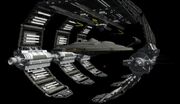
A basic CGI render of the Columbia spacedock
Doug Drexler was not entirely happy with the Earth drydocks of Star Trek: Enterprise . " While I thought the drydocks were well done, " he clarified, " I would have made them part of a larger yard encompassing a space office\transportation and residence hub, a supply yard-warehouse complex, and more local traffic. It all boiled down to the limits of a television schedule, and budget. " Drexler also personally preferred Star Trek: Enterprise 's three-fingered spacedock variant more than the series' five-fingered one . He opined, " The more modest three finger arrangement is more in keeping with the shows time frame, and smaller less sophisticated starship. " [1] (X) Explaining why a slightly different spacedock was created for housing Columbia NX-02 , John Eaves said, " It was just to show difference. We all hate to see shots and elements reused and called something new and different when it's in fact not, so being conscious of this the Eden [FX] boys added the extra time to make something new exclusive for the NX-02. " [2]
USS Enterprise spacedock info [ ]
The spacedock featured in Star Trek: The Motion Picture was absent from an August 1977 story treatment for the film's never-produced precursor, " In Thy Image ". ( Lost Voyages of Trek and The Next Generation , p. 28) The idea of the dock was suggested later that month, as the treatment circulated among the production team hired for the eventually-canceled television series Star Trek: Phase II (for which "In Thy Image" was intended to be the pilot episode). ( Star Trek Phase II: The Lost Series , p. 33) As such, the dock features in a 20 October 1977 first-draft script for "In Thy Image". ( Star Trek Phase II: The Lost Series )
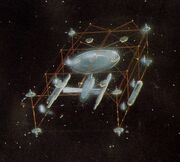
A web-like drydock designed for Star Trek: Phase II
A web-like mesh, representing this drydock, was included in a concept painting that illustrator Michael Minor created. ( The Art of Star Trek , p. 153) Andrew Probert , who worked as a production illustrator on The Motion Picture , later noted, " On Mike Minor's concept [of] the dock, he had rocket nozzles on the corners of the drydock for maintaining orbital position. " [3] Mike Minor also illustrated a variety of elevations exploring the dock. By 8 September 1977 , Minor had finished the various elevations and had turned them over to model builders Magicam , who were awarded the contract for building the majority of the studio models in September 1977. ( Star Trek Phase II: The Lost Series , pp. 43 & 44; Starlog #27, p. 26)
In October 1977 , the studio model for Phase II 's Earth spacedock was frequently tinkered with but remained unfinished. ( Star Trek Phase II: The Lost Series , p. 49) Due to a change of location for Magicam headquarters, the drydock was one of several Phase II models whose completion date was delayed to 4 November 1977 , as post-production supervisor Paul Rabwin reported to producer Robert Goodwin on 14 October of that year. ( Star Trek Phase II: The Lost Series , p. 51)
Gene Roddenberry wanted the spacedock to be in a geosynchronous orbit above the city of San Francisco . ( text commentary , Star Trek: The Motion Picture (The Director's Edition) ) Although this was written into a script draft of "In Thy Image" with the dock having a height of 200 miles, story editor Jon Povill sent a memo (on 14 October 1977) to the writer of the episode's script, Harold Livingston , that refuted this proposition. " I was asked to check with Jesco [ Jesco Von Puttkamer , NASA Technical Adviser to the production ] as to what orbital height was necessary in order to maintain a synchronous orbit over San Francisco, " Povill wrote. " It turns out that the only height at which a synchronous orbit can be maintained is 22,000 miles. " ( Star Trek Phase II: The Lost Series , p. 51) Livingston's revised first-draft script, submitted on 20 October 1977, duly altered the height to "several hundred miles." ( Star Trek Phase II: The Lost Series , pp. 51 & 131) Since the vast distance of 22,300 miles from the Earth would have made the planet seem like only a small ball, the dock's altitude was thereafter again lowered. ( text commentary , Star Trek: The Motion Picture (The Director's Edition) )
In November 1977 , the research company de Forest Research suggested that the references to "drydock" in the script for "In Thy Image" be replaced with "spacedock". ( Star Trek Phase II: The Lost Series , pp. 62-63 & 64)
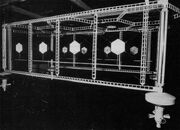
The studio model for Phase II 's spacedock
Phase II 's drydock model was evaluated, by Paul Rabwin and Robert Abel , as being "the best looking of all the models" built for the planned television series. ( Star Trek Phase II: The Lost Series , p. 72) In hindsight, however, Andrew Probert commented, " The [...] design was a box, with a very Earthbound look to it. " ( Starlog #32)
Due to the increased resolution demands of feature film photography, the drydock model had to be rebuilt from scratch, along with all the others constructed for Phase II . ( Star Trek Phase II: The Lost Series , pp. 70 & 71) In December 1977, Paul Rabwin contacted Robert Goodwin with suggestions from Robert Abel about how to upgrade the models, including the drydock. " Perhaps embellish elevators... 'busy' it up a little more, " noted Rabwin. " A new section of drydock should be built... the top and one side, so that angles from the side can be photographed. " These plans were considered as possible assignments for Magicam. ( Star Trek Phase II: The Lost Series , p. 72) In accordance with further advice from Abel, the drydock model was photographed while containing the unfinished Phase II Enterprise studio model . ( Star Trek Phase II: The Lost Series , pp. 72 & 71)
As it was decided to start over from scratch as far as the drydock studio model was concerned, the Phase II miniature – which was almost ready for an even-more delayed delivery date of 5 February 1978 – was discarded. ( Starlog #27, p. 29; American Cinematographer , January 1980, p. 153; Star Trek: Creating the Enterprise , p. 46) At a party held to commemorate the drydock model and the other Phase II miniatures prior to trashing them, the unsuccessful dock model (along with the original Enterprise model) was hung over a massive eight-foot by twelve-foot elevator table, on which lobster was meanwhile served for the production team. ( Star Trek: Creating the Enterprise , p. 46)
The Motion Picture 's screenplay refers to this structure as an orbital drydock. The main concept artwork featuring this drydock was created by Andrew Probert. ( The Art of Star Trek , p. 172) Revising the concepts for the drydock constituted his first assignment for the film. " We aimed for a design that would look like an extension of current NASA thinking for zero-g fabrication, " he said. ( Starlog #32) Probert studied Mike Minor's dock designs before starting work on reworking them. ( The Special Effects of Trek , p. 29)
During Andrew Probert's tenure on the drydock design, the earliest idea for the facility was to have it, in Probert's words, "fit the shape of the Enterprise as snugly as possible." ( Starlog #32) Hence, in some of his earliest concept sketches for the dock, the facility was more closely fitting to the exterior of the ship than it ultimately became. Probert stated, " My thinking was that the closer the dry dock is to the ship it's working on, you know, the more easier it would be for equipment and personnel to get down to the surface... or up to the surface! " [4] Probert initially envisioned the drydock as having the capability of expanding, a function that was not shown in the film. He commented, " I had actually envisioned four or five other drydocks in orbit nearby, servicing other starships of various sizes and shapes, and that would have shown how flexible the design was. " [5] (Look here to view early concept artwork for The Motion Picture 's orbital office complex , from which two sketches include the multiple, close-fitting drydocks.) Probert also experimented with the lighting of this dock configuration and created designs for cranes that were to be operated by workers laboring on the docked ships. [6]
By or in April 1978 , the spacedock was changed to having a more box-like shape, much as it appears in the final film. ( The Art of Star Trek , p. 172) Another of Andrew Probert's initial ideas was for the station to have a side hub that would serve as essentially a garage for workbees and include office areas as well as living quarters. [7] (X) This feature was detailed in at least two concept paintings, one of which was dated April 1978. Another design feature that was included in the same illustration (as well as in a separate group of concept sketches) was a concourse, intended to physically link the dock with the rim of the Enterprise 's saucer section. ( The Art of Star Trek , p. 172; [8] (X) ) Probert also initially envisaged expanding on Mike Minor's idea of having rocket nozzles as part of the dock. " I thought we could update that with some sort of an energy beam, " explained Probert. [9]
A concept painting from July 1978 included even more modifications on the dock's design. For example, the single side hub had been replaced with the pair of cargo/shuttlebays seen in the film. ( The Art of Star Trek , p. 172) Compared to Mike Minor's dock, the drydock Probert came up with was more open and less similar to a building's interior. ( The Special Effects of Trek , p. 29) (Some of Andrew Probert's concept artwork for the dock can be viewed here (X) , while an audio and visual presentation – with Probert commenting on these illustrations – can be accessed here ).
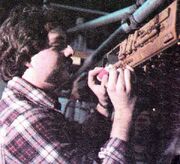
Ross detailing the drydock model
The studio model used for the new redesigned The Motion Picture spacedock was also built at Magicam, who were actually retained as the primary studio model building company. ( The Art of Star Trek , p. 173) It was the last studio model the company embarked upon, partly because Magicam's staff was, up until then, knee-deep involved with the construction of the revised eight-foot Enterprise model , partly because redesigned elements of the drydock kept coming in, and partly because it took months to put together thousands of parts needed to assemble the model, which was only half in jest dubbed "the kit" by Jim Dow . ( Starlog #27, p. 29) The model maker who was appointed lead modeler for the build of the miniature was Magicam employee Russ Simpson , heading a team that involved, among others, Chris Ross . [10] Costing US$250,000, the drydock model was four feet high, six feet wide, and ten and a half feet deep. It had fifty-six neon panels that required 168,000 volts of electricity. ( The Making of Star Trek: The Motion Picture , p. 210) The neon lighting was installed by a sub-contracted specialist, Larry Albright , whereas the more conventional incandescents were installed by Magicam's own Paul Turner . ( American Cinematographer , February 1980, p. 178) Each of these six-by-six-inch neon grids required three thousand volts of electricity to operate, so each neon tube had a transformer which provided the power via large cables. Magicam completed the drydock over a span of five months, constructing it with half-inch glass tubing twisted into shapes by an aerospace tube bender facility. The tubing supported thousands of small wires. ( Trek: The Unauthorized Story of the Movies , pp. 29 & 28) The model was constructed out of nearly 100,000 custom-made parts, many of which plastic, and came in at 350 pounds, when delivered for filming. ( American Cinematographer , February 1980, pp. 178-179)
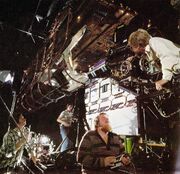
The model of this drydock being readied on a stage at Future General Corporation
Douglas Trumbull , who directed The Motion Picture 's special photographic effects, devised ideas to both improve and simplify the lighting and filming of the drydock model. He also supervised the photographing of the model. ( The Making of Star Trek: The Motion Picture , p. 206) This filming was initially intended to be done on Paramount Stage 2 . ( The Making of Star Trek: The Motion Picture , p. 215) However, one of Trumbull's stages at Future General Corporation ultimately served as one of the filming sites, if not the only one. ( The Making of Star Trek: The Motion Picture , interior color photographs & p. 206) On-stage preparations for filming the model involved special effects technicians Bob Spurlock , David Gold , Pat van Auken , Dave Stewart and Jonathan Seay . ( The Making of Star Trek: The Motion Picture , interior color photographs) Cameraman David Hardberger also contributed to the preparations. ( Cinefex , issue 1, p. 10) Transformers supplying the vast amounts of battery power needed to run the miniature's neon panels were positioned on a separate table. ( The Making of Star Trek: The Motion Picture , p. 210) Daren Dochterman – visual effects supervisor for Star Trek: The Motion Picture (The Director's Edition) DVD – remarked, " The dry-dock itself was shot in front of what's called a front-light/backlight process, meaning it's not blue screen, but they would shoot one pass with a brightly lit background and no lights on the foreground. And then they would do the same pass with the models lit correctly. And the bright pass would serve as a matte to insert stars or the Earth behind it. And in this way, they could much more carefully craft the lighting on the miniatures rather than have to worry about blue from the blue screens. So, this allowed them to get some amazing shots with a Snorkel camera. " ( audio commentary , Star Trek: The Motion Picture (Blu-ray) )
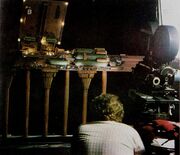
The enlarged partial model filmed by Stewart
At least one other partial model was built for the dock, used in close-ups of one side of the facility. This model was larger and considerably more detailed than the main miniature of the dock. ( audio commentary , Star Trek: The Motion Picture (Blu-ray) ) Construction of the model was deemed necessary for those instances where it was felt that adequate depth of field could not be obtained by using the combination of both full-size miniatures. The footage shot of the detail model was, in post-production, matted over that of the Enterprise . ( Cinefex , issue 1, p. 12)
For its appearance in Star Trek II , the dock was scripted to be shown via recycled footage from The Motion Picture . [11] This was also how the dock was represented in the actual film version of the sequel. ( text commentary , Star Trek: The Motion Picture (The Director's Edition) DVD ; et al. ) The amount of footage of the dock was minimized, though. Mike Minor recalled, " We worked out a way [...] [of] cutting that interminable 'look-at-us-aren't-we-great-special-effects-people' trip around the Enterprise spacedock. " ( Enterprise Incidents , issue #14, p. 51)

Similar drydocks at Utopia Planitia
The studio model for this drydock was heavily modified for use as the Starfleet drydock in Star Trek Generations . [12] [13] When it came time to create the newer type of spacedock, the model for The Motion Picture version was sent to Industrial Light & Magic . Years later, ILM Visual Effects Supervisor John Knoll related, " I remember when the model got shipped up here and we opened up the crate, looked at it, that was a special moment for me. " ("Industrial Light & Magic – The Next Generation", Star Trek: First Contact (Blu-ray) ) Reusing the model as Starbase 375 was an option for the visual effects artists who worked on Star Trek: Deep Space Nine , though they ultimately opted to use a different model. ( Cinefantastique , Vol. 30, No. 9/10, p. 35) Drydocks of both types used in The Motion Picture and Generations were additionally located at the Utopia Planitia Fleet Yards above Mars in the 24th century , as shown in the Star Trek: Voyager episode " Relativity ". Neither variation shown in that episode was a physical model but rather a CGI model , constructed at Foundation Imaging under the supervision of Adam Lebowitz . ( Star Trek: The Magazine Volume 1, Issue 6 , p. 50) Brandon MacDougall was the modeler responsible for constructing the CGI version of the drydock in its original configuration. [14]
USS Enterprise -E spacedock info [ ]
Very few structural details about this spacedock from Star Trek Nemesis were included in the film's shooting script, which describes its inner enclosure as merely "the great womb of a spacedock." [15]

The second concept sketch that John Eaves created for the dock
The final exterior design for this spacedock was created by production illustrator John Eaves , who described the dock as "a fun piece to work on." [16] Eaves took his inspiration for the spacedock from the earlier drydock shown in The Motion Picture . Shortly after working on Nemesis , Eaves commented about the spacedock, " The new one is still very open, because we're flying across the surface of it and you really want to see the Enterprise from the outside of the dock, as well as the inside; but what we tried to do with this one was make it unique for the Enterprise – a custom port for that sovereign class of ship. " ( Cinefex , No. 93, p. 111) Eaves later remembered, " At Paramount , we had come up with some Space Dock designs, and they were not too much of a high point with importance visually, so they went through the approval process with only one cosmetic change. The top of the dock had a considerably large living complex, and the producers opted for a minimal area, [so] as to keep the frame work more open. Sketch two did this, and the final part of the dock was the docking coupler [....] This [spacedock] was to be a broader design as to accommodate more [than] just the 'E', but there was little concern for these details based on the secret fact that this was to be the last TNG film . " [17]
Meanwhile, Digital Domain artist Darryl Anka had also been given the task of designing the spacedock, unbeknownst to John Eaves. As Eaves delivered his concept sketches of the dock from Paramount to Digital Domain, he discovered Anka's connection to the project. " We received the fax of Darryl's drawing, " stated Eaves, " which was a cool design that mixed a little bit of the original and the dock created for the NX-01 . Seeing the name on the bottom is how I found out that Darryl was on the show too! Sadly, his idea was presented too late to get in the run. " Despite this, the spacedock in Star Trek: Nemesis includes a worker pod design that Darryl Anka did successfully contribute. [18] Furthermore, it was Digital Domain who actually visualized John Eaves' artwork on-screen, creating a virtual model of the spacedock based on his concept art. ( Cinefex , No. 93, p. 111)
Regarding the docking coupler which (in the movie) links the dock with the Enterprise -E, John Eaves admitted, " You don't really get a clear view of that little feature unless you know what your looking for! " [19]
- 1 Abdullah bin al-Hussein
Memory Beta, non-canon Star Trek Wiki
A friendly reminder regarding spoilers ! At present the expanded Trek universe is in a period of major upheaval with the continuations of Discovery and Prodigy , the advent of new eras in gaming with the Star Trek Adventures RPG , Star Trek: Infinite and Star Trek Online , as well as other post-57th Anniversary publications such as the ongoing IDW Star Trek comic and spin-off Star Trek: Defiant . Therefore, please be courteous to other users who may not be aware of current developments by using the {{ spoiler }}, {{ spoilers }} OR {{ majorspoiler }} tags when adding new information from sources less than six months old (even if it is minor info). Also, please do not include details in the summary bar when editing pages and do not anticipate making additions relating to sources not yet in release. THANK YOU
- Memory Beta articles sourced from comics
- Memory Beta articles sourced from comic adaptations
- Memory Beta articles sourced from reference works
- Memory Beta pages needing citation
- Memory Beta articles sourced from magazines
- Memory Beta articles sourced from video games
- Memory Beta articles sourced from games
- Memory Beta articles sourced from Star Trek Online
- Space stations
- Federation shipyards
Earth Spacedock
- View history
- 2.1 Shuttlebay
- 3 Cadet training
- 6 External links
Summary [ ]
Earth Spacedock, referred to simply as "Spacedock" was the largest Starfleet spacedock structure in near-Earth orbit . Other space-built structures might have been larger, but none was ever built as close to the planetary surface. It was originally conceived as a military base for ship repairs and refits. Spacedock orbited Earth just within the Van Allen radiation belts . The close proximity to the denser layers of Earth's atmosphere would normally cause the station's orbit to decay so it was fitted with massive impulse engines that maintained its orbit. The outer doors were at some point enlarged to fit ships as large as the Galaxy -class starship.
Design, facilities and functions [ ]
Designed as a permanent base for the many ships traveling the Sol System . It could easily provide refit and repair facilities for up to 8 cruiser -sized starships and up to 24 of Starfleet's lesser-sized ships.
Although Spacedock was a vital link in Starfleet Operations and was administered by Starfleet Command , [ citation needed ] it was not an actual starbase . Being intended primarily as a military installation, it was originally designed to be equipped with 40 massive phaser banks, but the United Earth government objected to the presence of more weapons in Earth's orbit. [ citation needed ] A compromise was eventually reached and it was constructed weaponless, relying on high-powered deflectors . Nonetheless it retained its 40 weapon mounts, in case of interstellar war emergency, Starfleet Command can mount phaser weapons and have them operational within a single week. [ citation needed ]
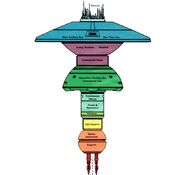
Earth spacedock layout.
Another major purpose of Earth Spacedock was its ability to scan all of Solar space. The docking port became one of the central installations for weather-watch, debris- scan , radiation -flux analysis, and starship traffic control, for Sector 001 . This was made possible by the largest single sensor array and subspace communications equipment known at that time. Antennae were placed at the top of Spacedock, which were so sensitive they could detect a meter -sized object in the Solar System's cometary halo, at least half a light-year away. [ citation needed ]
In addition to its military and traffic control functions, Spacedock also became a commercial focal point for the Sol sector. Starfleet leases office space, warehouse facilities, cargo transporters, and trade arbitration for many of the more important commercial corporations. Because of its value as a trans-shipment point for both passengers and cargo, Spacedock also developed a thriving tourist trade. Its kilometers of wide halls were filled with shops, vendors, services and restaurant facilities catering to a wide range of races. It would eventually rival the Rigel star system as a source of revenue. What made this remarkable is that this commercial aspect of Starfleet's Repair and Service Facility had developed in a span of less than five years . [ citation needed ]
Earth Spacedock also provided the most extensive medical facilities in near-Terra orbit, rivaled only by those of the LaGrangian colonies in their completeness and scope of operation. The gravity of the station was entirely under the control of Starfleet engineers at any point in the station, so that the hospitals could be provided with any type of environment settings needed by species. The ongoing research being conducted here began to provide clues to the cures of many unsolvable medical mysteries. ( Stardate Magazine vol. 1 (1984), Issue 1: "The Serpent Factor")
Spacedock also housed a stateroom for conferences, and the lounge Club 47 .( STO mission : " Welcome to Earth Spacedock ")
In the late 24th century , several classes of Starfleet starships were commonly built at Spacedock 1, including the Saber -class and the Norway -class . ( DS9 reference : Star Trek: Deep Space Nine Technical Manual )
Shuttlebay [ ]

Spacedock shuttlebay .
One shuttlebay was located on deck 47. Hangar doors opened to space to allow easy landing and departure for Federation shuttlecraft . A logistics officer was assigned to the area. The standard complement in the 2400s and 2410s decades included workbees , Type-8 shuttlecraft and Yellowstone -class runabouts . ( STO - Klingon War mission : " Welcome to Earth Spacedock ")
- Type-8 shuttlecraft
- Yellowstone -class runabouts
Cadet training [ ]
Earth Spacedock had become an auxiliary of Starfleet Headquarters , based in San Francisco . The wide variety of operations conducted at Spacedock made it an ideal training laboratory for Starfleet Academy . Cadets would get their first space experience there. No matter what branch of service the Cadet may eventually enter, the spacedock provided experiences related to almost every facet of Starfleet operations. Engineering cadets be exposed to tours of the facility's stabilizing impulse engine system and anti-matter reactors.
Because Starfleet provided security for the Spacedock, this gave on-the-job training in security and also familiarized the officer-to-be with the many different races that made up the Federation. The facility also provided great teaching grounds for Science , Medicine , Astrogation , and administration. ( Stardate Magazine vol. 1 (1984), Issue 1: "The Serpent Factor")
History [ ]
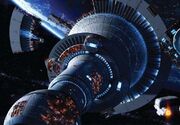
Earth Spacedock under construction.
Construction of Earth Spacedock began some time before late 2257, and was still in progress by the time the Federation-Klingon War of 2256-57 ended. ( DSC episode : " Will You Take My Hand? ")
According to another account, the station was fully operational, and in its final "mushroom-shaped" configuration as early as 2250 . ( TOS novel : Academy: Collision Course )
The USS Excelsior was at the moment the most important project completed within the Spacedock. ( Stardate Magazine vol. 1 (1984), Issue 1: "The Serpent Factor")
By 2409 , Spacedock served as the central hub of Starfleet Command and was under the command of Admiral Jorel Quinn , with Akira Sulu as second-in-command. ( STO mission : " Welcome to Earth Spacedock ") It was briefly a completely different design before Q Junior restored it to its classic look.
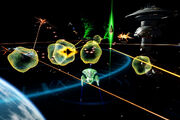
Undine attack on Earth Spacedock.
In 2410 , Earth Spacedock was heavily damaged during the Undine assault on Earth and Qo'noS. It received a refit some time after the incident. ( STO mission : " Surface Tension ")
The station was attacked again as part of the Iconians ' final assault on the Alliance. After the battle and the Iconian War ended, the station was rebuilt yet again. ( STO mission : " Midnight ")
See also [ ]
External links [ ].
- Earth Spacedock article at Memory Alpha , the wiki for canon Star Trek .
- Earth_Spacedock article at The Star Trek Online Wiki .
- 1 The Chase
- 2 Preserver (race)
- 3 Tzenkethi
- More to Explore
- Series & Movies
Published Jan 30, 2017
Starbases of The Federation: From K-7 to Yorktown
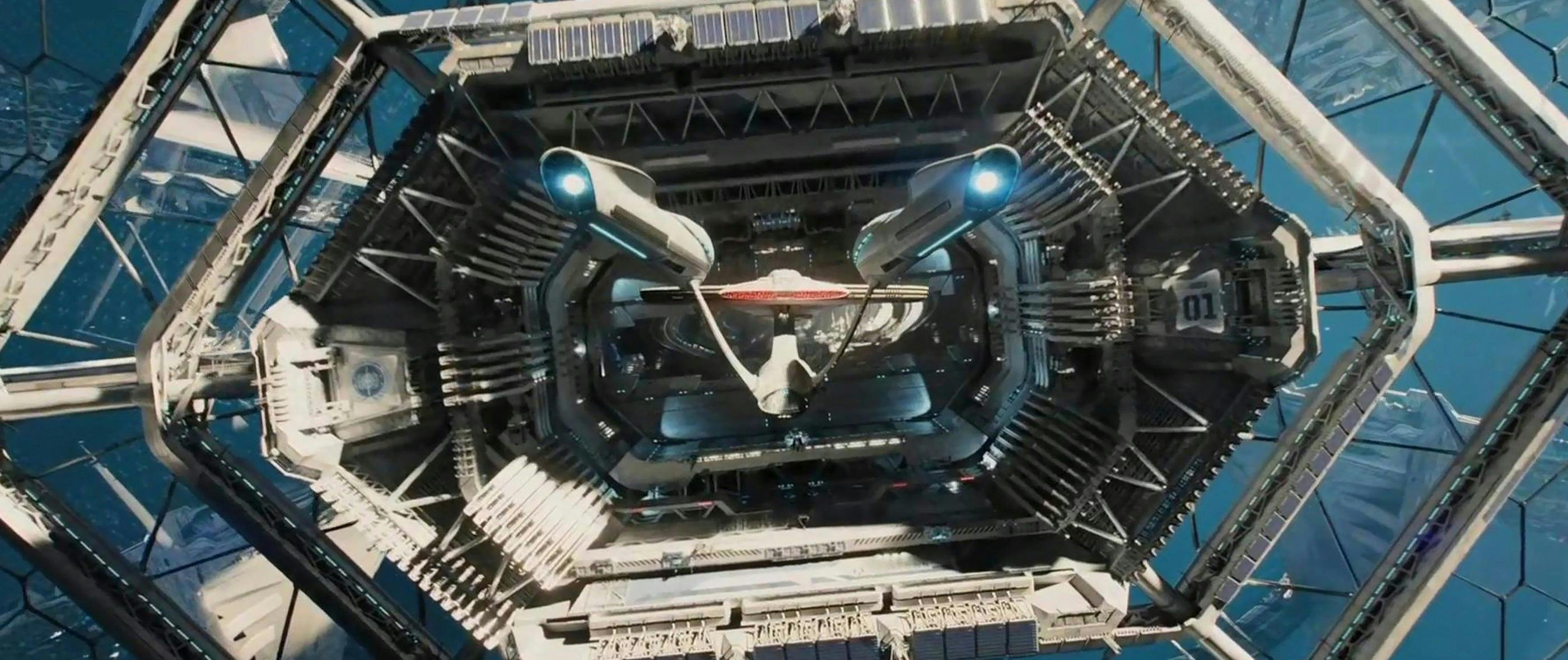
The United Federation of Planets relied on its massive fleet of iconic starships to seek out new worlds in the 23rd and 24th centuries, but its network of starbases and outposts proved just as valuable to the exploration of space and the protection of Federation citizens. Most space stations shared similar roles, such as maintaining the capability to repair starships, but the type and location of each outpost dictated its primary role. While many starbases also included ground-based elements, this piece will only focus on the spaceborne facilities.
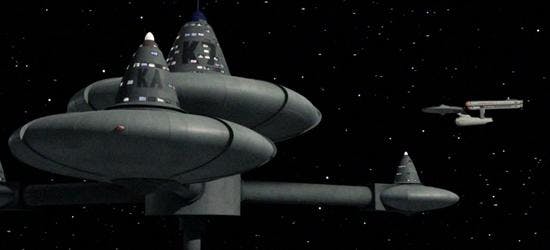
Deep Space Station K-7, introduced in the Star Trek: The Original Series episode " The Trouble with Tribbles ," played a vital role in the Sherman's Planet region claimed by the Federation and Klingon Empire. Acting as Starfleet's presence in the area, K-7 also served the tactical purpose of observing the Klingon border and providing storage for the development of Sherman's Planet. As with most starbases, K-7 maintained facilities to entertain weary travelers, Federation officials and even Klingon warriors. The relatively small station still retained the ability to store significant quantities of quadrotriticale, the grain necessary to seed Sherman's Planet and secure the Federation's claim on the world. Thus, Deep Space Station K-7 performed multiple functions, ranging from protecting the border to asserting ownership over territorial gains.
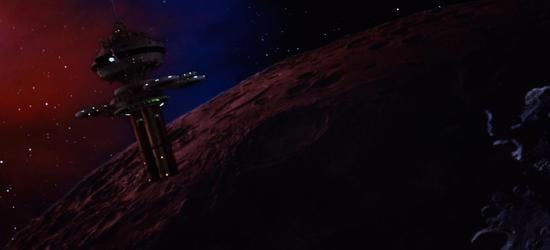
The Federation outpost Regula I worked toward a very specific goal in the Mutara sector during the events of Star Trek II: The Wrath of Khan . Operated by civilian scientists, the station was tasked with the advancement of the Genesis Project. Regula I's remote location proved a necessity, allowing for discrete and undisturbed research. Due to its classified mission, Regula I did not permit casual guests or publicly announce its true purpose, whereas other Federation starbases tended to do so. The outpost's small size probably meant it had limited starship repair capabilities, if any at all. The U.S.S. Reliant, attached to Regula I as a scout vessel, most likely traveled to other stations for its upkeep.
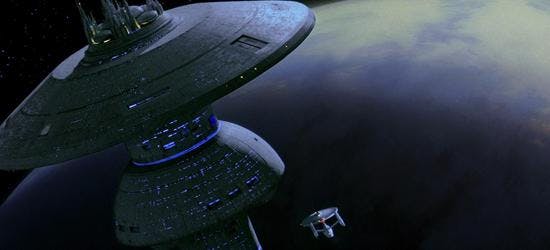
The massive form of Earth Spacedock easily eclipsed the various starships that docked in its berths and visited Sol III. The station launched new vessels, repaired others and decommissioned obsolete ones while maintaining a detachment of active starships ready to defend Sector 001. Although never canonically stated, Spacedock's size and strategic location seem to indicate its complement also included defensive weaponry for Earth's protection. In this sense, the starbase performed the role of securing a particular region of space, much like K-7. However, the Federation charged Spacedock with the fortifying its very heart rather than the edge of explored space. While the station's status as a shipbuilding facility remains unclear, the U.S.S. Excelsior did undergo tests and early transwarp trials at the starbase.
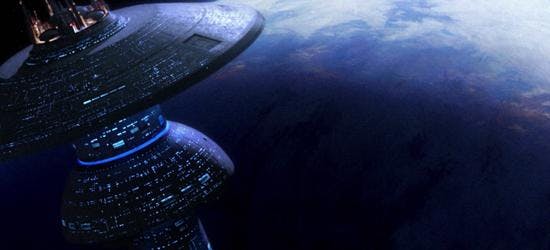
Stations similar in design to Earth Spacedock, such as Starbases 74, 84, 133, and Lya Station Alpha, appeared numerous times in Star Trek: The Next Generation . Why would Starfleet also construct these large outposts in seemingly innocuous systems rather than only near worlds central to the government? Ironically, the question most likely answers itself. As the regions where the stations were located tended to be away from major population centers, logic dictates that the starbases functioned as hubs for Federation activity in distant but strategically positioned areas. Sectors devoid of core planets require a place to repair starships, offer respite to weary crews, and fortify Starfleet's presence outside of prominent systems such as Vulcan, Andor, Sol, Tellar, Betazed and Trill.
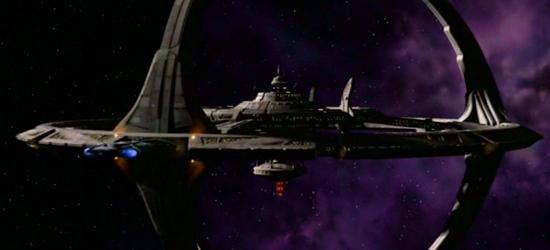
The renowned port of Deep Space 9 changed its mission, and its location, following the joint Federation-Bajoran takeover of the station. Originally known as Terok Nor, a Cardassian ore-processing plant and symbol of occupation, the starbase became the operational center overseeing the rebuilding of Bajor. DS9 soon gained an additional task when Commander Sisko and Lieutenant Dax discovered the stable wormhole to the Gamma Quadrant in the Denorios belt and moved the station close to the anomaly. Suddenly, the starbase found itself to be an important locale for trade and exploration, welcoming travelers from Qo'noS, Vulcan and beyond.
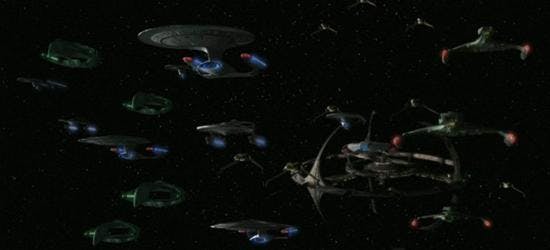
As the threat from the Dominion increased and a full-scale war erupted, Deep Space 9 earned a reputation for its vital part in guarding the wormhole and preventing reinforcements from entering the Alpha Quadrant. The starbase displayed versatility in taking on additional roles beyond its original mandate to watch over Bajor, also acting as a repair hub for Federation, Klingon and Romulan forces during the war. From refinery to strategic necessity, Deep Space 9 helped to shape the future of Bajor, the exploration of the Gamma Quadrant and the outcome of the Dominion War.
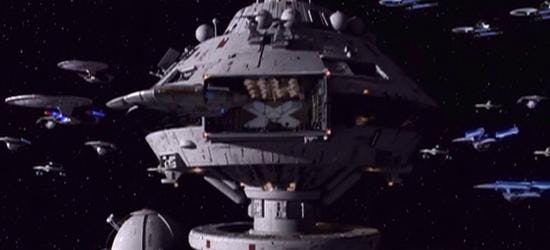
When Cardassian and Dominion forces reoccupied Terok Nor in the Star Trek: Deep Space Nine episode " Call to Arms ," the Federation lost its primary foothold against its foes. Starbase 375's proximity to the combat zone made it the natural fallback position for Starfleet. Otherwise a typical Federation station, Starbase 375's location turned it into a key staging area for starship deployments and Operation Return, the mission to remove the Dominion's presence from Deep Space 9. The progression of the war shifted the purpose of Starbase 375 to an unexpected trajectory, again displaying the adaptability required for Federation stations to operate at maximum efficiency.
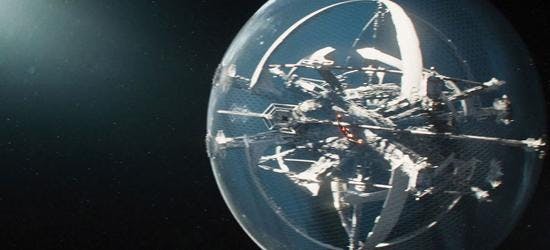
A highlight of the film Star Trek Beyond , Starbase Yorktown proved to be a visually stunning marvel of technology. Easily the largest Starfleet facility ever depicted, the intricate structure houses millions of inhabitants and serves every duty imaginable. Located near uncharted space and the Necro Cloud nebula, Starbase Yorktown resupplies vessels, conducts repairs, builds new starships, acts as a home for crews and their families, dispatches missions of exploration, flies the Federation flag in the region and maintains defensive armaments. With its sprawling arms covered in cityscapes, interior tunnels funneling starships to their births and awe-inspiring transparent exterior, Yorktown represents the peak of Starfleet engineering. In addition to its variety of practical uses, Starbase Yorktown also helps the Federation avoid diplomatic incidents between new members by being positioned in interstellar space, rather than on the surface of a particular planet.
Without a reliable system of starbases, Federation vessels would not be able to function in deep space for extended periods of time. Starships receive most of the glory, but these stations offer safe harbors and defensible locales upon which the fleet relies. Whether orbiting Earth, overlooking the Bajoran wormhole, or sitting on the edge of the frontier, starbases ensure that crews always have a home away from home to visit.
Jay Stobie is a science fiction writer who admits he has a perfectly normal obsession with Star Trek. He can be found on Twitter at @CaptStobie .
Get Updates By Email

Designing Earth Spacedock
Industrial Light and Magic’s David Carson and Nilo Rodis designed Earth Spacedock for Star Trek III: The Search for Spock . Carson told Star Trek: The Magazine in 2002 that he was thinking of ways to make the space station interesting and thought, “What if it is so big that the Enterprise actually goes into it?”
I did a drawing of a space station that was big enough. It was a bit clunky, but Nilo took that and in his typical fashion turned it into a really wonderful design. So we presented this idea.
“We pitched a whole bunch of design ideas to Harve [Bennett] and Leonard [Nimoy],” Rodis recalled. “I wanted to make sure it had nothing whatsoever to do with Star Wars .”
The original plan was to rotate the facility as it proceeded on its orbit, which meant that starships maneuvering into the station would have to synchronize their motion with the dock. This was dropped.
The scale of the spacedock presented a challenge. It had to look massive on the inside without making the Enterprise look small.

Seeing the ship dock through a large group of windows partly solved that issue. The presence of people in the foreground provided a reference point for scale.
“Because there was no architectural detail on the inside, I needed an element that defined how big this space was,” explained Rodis.
The only way I could really give you the sense of distance was by establishing some kind of perspective. We could do that vertically, but we also needed to do it between them with beams or columns of light.
The inclusion of lights also added a sense of grandeur. “Without that element,” Rodis said, “it just wasn’t magic.”

Building the model — twice

A full-scale studio model was built at ILM. To represent the interior of the Spacedock, a large 30-foot miniature was constructed. “That was an elaborate electronic feat with all the neon and the working doors,” Ken Ralston remembered.
There was kind of an interesting weird soft light in there, and I was so specific about the color I wanted to achieve inside that spacedock. I went round and round on it for a long time and then fought with the lab to print it correctly.
The miniature was destroyed after Star Trek III , which meant a new one had to be built for the next movie.
Modelmaker Jeff Mann later told The Making of the Trek Films that rebuilding the model was a “major undertaking”.
We had wanted to use stock footage of the interior of the spacedock from Star Trek III . We hoped that we could take some of the old effects elements from that scene and composite them with some new movement, but nothing worked quite right, so we had to refurbish and rebuild it.
No fresh scenes were show for Star Trek V , but Art Director William George wanted something original for Star Trek VI: The Undiscovered Country . He told Cinefex in 1992 that he looked at the model from all angles and ended up lying down on the ground to look up before he realized that was the perfect shot. “It hadn’t been seen before, plus it was the natural angle of approach if you were coming up from Earth.”

I entirely agree with Andrew Probert, the Enterprise being a very large and formidable spaceship would have no logical reason to go inside the “Spaced Dock” space station. That feature of the “Space Dock” in basic engineering terms would be an extreme waste. That idea is as bad as building the Enterprise on the ground instead of space where in a space faring era it would be easier and more economical, as it was in JJ’s movie.
But it looks cool! Also having starships dock inside a spacedock goes all the way back to the old Starfleet Technical Manual .
Even aircraft carriers have to port. Spacedock makes sense for repairs and construction.
There are reasons for a grand scale spacedock. 1) Being able to defend inoperable ships from casual inspection or attack. 2) Control access to potentially valuable strategic secrets. 3) Protect human operations crew while doing their work from radiation, attack, debris, etc. 4) Win friends and intimidate enemies.
Every sci-fi movie I ever saw chose theatricality over the more interesting real features of space as a home away from home. I’m hoping one day I can watch real space in a movie as depicted in Arthur C. Clarks and Stanley Kubrick’s 2001 .
Truly one of the classics in sci-fi effects. You really get a sense of the scale! Somehow this would just feel so… ronky-ponky and fake if they made this now, since it would almost certainly be done in CG. Practical effects forever!
Submit comments by email .
- Missions without enemy group
- Delta Recruitment Event
Mission: Welcome to Earth Spacedock
- VisualEditor
- View history
- Free Starship Modification
- [ Phaser Beam Array Mk I [???] ]
- [ Console - Tactical - Phaser Relay Mk I ]
- Battery Pack
In Welcome to Earth Spacedock the player visits Earth Spacedock for the first time and is given the permanent commission to command her/his starship .
Synopsis (for 25th century players) [ | ]
After the incident at Vega, Admiral Janeway orders the player to Earth Spacedock . At the spacedock, Admirals Janeway and Quinn recognizes the player for the extraordinary actions during the Borg ambush and the subsequent invasion of the Vega System . With Captain Taggart currently out of commission, Quinn confirms the player's previous field promotion to Lieutenant and permanently places the starship under her/his command.
Outline [ | ]
Mission text [ | ].
Welcome to Earth Spacedock !
Meet with Admiral Quinn for new orders. You're on the command track!
Objectives [ | ]
- Meet Admiral Quinn

Allies [ | ]
Federation [ | ].
- Elisa Flores
- Admiral Quinn
Accolades [ | ]
(25th C. captains only)
Walkthrough
Notes [ | ].
- The Battery Pack reward consists of 3x [ Shields Battery ] and 3x [ Weapons Battery ] .
- Originally part of the Tour of Duty Federation tutorial, the mission has been moved into the Klingon War episode eventually, now being the first Federation storyline mission. The previous version of this mission was titted “New Orders?” .
- With the release of Season Twenty-six: Stormfall , the player must now directly travel to the Sol System from sector space. They will still be automatically beamed to ESD however.
- After completing this mission, three additional tutorial missions become available through Ensign R'raak in front of Quinn's office: “Changing Clothes” , “Medical Attention” , and “Skills Trainer” . Those missions were originally given by Admiral Quinn.
- At turn-in players will have earned at least a total of 11920 Skill Points. Having played the full tutorial through, most players will have earned over 12000 Skill Points, and be promoted to Lieutenant (Level 3). Players that skipped the full tutorial through “Passing Credit” , will be exactly 80 points short.
- Completing the mission will promote the character to level 6 during a Bonus Experience Weekend , and get them to a total of 22,992 Skill Points (with 52 Skill Points coming from the accolade obtained by completing this mission).
- The redesign of this mission allows veteran players a quicker start into the storyline and patrol missions, but requires new players to explore Earth Spacedock more by themselves, through interaction with the NPCs or occasional pop-ups. Additional missions with tutorial character include “Unlocking the Box” , “Out of Commission” , and “A Difficult Decision” .
- Although this mission is the same essentially the same for 23rd and 25th C. captains there are some differences listed above.
- 2 Delta Recruitment
- 3 Playable starship
What Star Trek Looks Like Before Special Effects
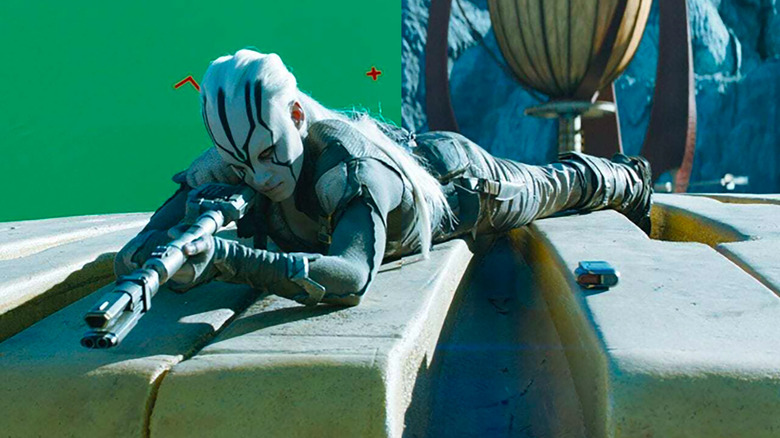
"Star Trek" is one of the most iconic and enduring science fiction franchises of all time, following the adventures of Starfleet in the far-future as they explore space, the final frontier. To bring strange new worlds and civilizations to life, "Star Trek" leans heavily into visual effects, many of them cutting edge for technology available at the time. These special effects did everything from showcasing the starship Enterprise to making the ship's memorable transporter look seamlessly functional. Simply put, "Star Trek" wouldn't be what it is without its meticulously realized visual effects.
It takes a whole team and a whole process to bring these futuristic sights to the screen and these behind-the-scenes photographs offer a look at how it was all made. From extensive use of models and bluescreen to modern digital projection, "Star Trek" uses every visual effect trick in the book to thrill audiences. Here is what "Star Trek" looks like before all the special effects magic.
Khan gets his own space ride
One of the most notable episodes from "Star Trek: The Original Series" is "Space Seed" from the first season. The episode introduces genetic superhuman Khan Noonien Singh (Ricardo Montalban), who went on to become the primary antagonist in "Star Trek II: The Wrath of Khan" in 1982. Khan and his fellow superhumans are exiled from Earth on an automated freighter, the Botany Bay, encountered centuries later by the Enterprise. After finding the ship in deep space, the Enterprise docks alongside it to investigate the wayward starship for themselves.
American Cinematographer recalled the lengths the production went to capture the deep space adventures of the Enterprise, using a number of different effects. Like the Enterprise, the Botany Bay had its own scale model constructed, a technique used since the series' second episode "Charlie X." Both ships were filmed together against a blue screen, with the starry background added to the shot in post-production. This method demonstrates the scale of the Enterprise, compared to the much smaller freighter.
The Enterprise takes flight again
A full decade after the cancellation of "The Original Series," fans were treated to the return of the Enterprise and its crew with 1979's "Star Trek: The Motion Picture." A special reverence was taken in bringing the Enterprise to the big screen, including a sequence of Kirk and Scotty touring the outside of the hull in a shuttlecraft. After reuniting on board, the Enterprise sets out to confront V'Ger, a cloud-like entity headed towards Earth destroying all in its path. Like many visual effects of the era, the Enterprise's recommissioned voyage is a mix of practical and digital effects.
The behind-the-scenes documentary "Sense of Scale" depicts the painstaking attention to detail and work that went into creating the Enterprise model for "The Motion Picture." A photo from the documentary by Piercefilm Productions reveals the sheer size of the Enterprise model during production on the 1979 movie. Crew members around the model assemble plates, which will be used to impose the Enterprise in space in post-production. Back and literally bigger than ever, the Enterprise's cinematic debut used the best in contemporary special effects technology to impress audiences.
The Klingons strike in Star Trek III
Leonard Nimoy took the helm of 1984's "Star Trek III: The Search for Spock," pitting the Enterprise against the Klingons. The longtime "Star Trek" enemies make their grand entrance in the film as their Bird of Prey decloaks while searching for information on the Genesis Project. The sight is one of the more impressive moments in the film, firmly reestablishing the Klingons as a genuine threat. For help developing the visual effects for "The Search for Spock," Nimoy turned to "Star Wars" effects company Industrial Light & Magic .
Nimoy approached ILM early during production on "Star Trek III," creating scale models for the Bird of Prey and Starfleet's orbital space station, Spacedock. A behind-the-scenes photo from the production shows VFX supervisor Ken Ralston working with ILM for shots involving the Bird of Prey. Impressed by their work on "Star Trek III," Nimoy collaborated with ILM when he resumed his directorial duties for "Star Trek IV: The Voyage Home."
Spock joins Kirk at Yellowstone
The first time Captain Kirk and his friends are seen in 1989's "Star Trek V: The Final Frontier," they aren't on an interplanetary mission, but enjoying a much-needed vacation. Kirk, Spock, and McCoy decide to go on a camping trip at Yellowstone, with Kirk going on a free solo climb of El Capitan. Spock interrupts his climb, rapidly catching up with the aid of hover boots, to question why his friend would indulge in such a dangerous activity. While long shots were filmed on location at El Capitan, the close-up shots involving actors William Shatner and Leonard Nimoy were not.
This behind-the-scenes picture from the special edition DVD release of the movie shows Nimoy standing comfortably on a platform, with a fiberglass composite of El Capitan's face positioned next to him and Shatner. Yosemite and its sweeping vista is seen in the background, with the production taking advantage of the on-location filming. Having the actual landscape in frame helps lend the illusion that Kirk and Spock are actually by Yosemite as Kirk makes his daring climb.
The Borg Queen makes her entrance
One of the most sinister antagonists in all of "Star Trek" is the Borg Queen, introduced in 1996's "Star Trek: First Contact." After the Borg Collective infiltrates the Enterprise, turning its engineering bay into a makeshift headquarters, the Queen reveals herself to Data. As the Queen delivers her opening monologue, the upper half of her torso is lowered onto a waiting body. Seamlessly executed, the Queen attaches to her lower half and walks to Data in a single take, without missing a beat.
A behind-the-scenes photo from Paramount Pictures shows "First Contact" director Jonathan Frakes on set with actor Alice Krige in her Borg make-up. The robotic torso is fixed to the floor while Krige's lower half is covered by bluescreen material to facilitate the illusion of it initially being missing. Though Krige moves normally during filming, post-production creates the effect of her affixing to her body and walking. The resulting scene is one of the most visually impressive moments in "Star Trek" history, with a variety of tricks used to bring it all together.
The Star Trek reboot's innovative outdoor shoot
When filmmaker J.J. Abrams resurrected "Star Trek ," starting with an eponymous reboot film in 2009, this new take on the franchise had a decidedly more action-oriented approach. One of the biggest set pieces in the 2009 movie has Kirk and Sulu skydiving from a shuttlecraft above Vulcan onto a Romulan mining platform blasting into the planet. While the precariously hanging platform, Kirk and Sulu fight the Romulans operating it before destroying it in a desperate bid to save Vulcan. Rather than being filmed inside of a studio, the sequence was filmed outside, albeit far from being shot on-location.
Footage from an Industrial Light & Magic "Star Trek" featurette shows production of the mining platform scene, which reveals that it was shot in a parking lot. This exterior approach gave the scene the natural feeling that the actors were outside while still in a tightly controlled environment. The skies above Vulcan and, of course, the massive mining laser, were added digitally in post-production, with greenscreen on the ground to facilitate this. This approach paid off, with "Star Trek" earning an Academy Award nomination for Best Visual Effects for its hard work.
The Klingon home world is a digital construction
One of the biggest action set pieces in "Star Trek Into Darkness" involves a covert mission to recover the villainous Khan (now played by Benedict Cumberbatch) on the Klingon home world of Kronos. The Klingons themselves are heavily redesigned from past "Star Trek" appearances, introduced moments before Khan massacres them in a prolonged gunfight. The battle is set in a rocky region of Kronos, with ash atmospherically falling around the combatants before Khan surrenders himself to Kirk and his landing party. Of course, none of the background on Kronos is actually real.
While the costumed actors are on set for the Kronos sequence, the landscape around them was created and superimposed around them via blue screen, as revealed in a VFX reel from Pixomondo . Lights around the set help make the Klingons appear more intimidating, lending a subtle shadow effect. With so much of "Star Trek Into Darkness" set in Starfleet locations, Kronos is among the most visually striking places in the movie. And though the entire sequence feels like it's shot on a soundstage, how much of it never physically existed is a bit surprising.
Star Trek Into Darkness digitally creates another planet
To take down Khan in "Star Trek Into Darkness," Starfleet Admiral Alexander Marcus (Peter Weller) has the Enterprise loaded with specially designed torpedoes. Suspicious about this secret weapon, Hank McCoy (Karl Urban) and Doctor Carol Marcus (Alice Eve) defuse and disassemble one of the torpedoes on a remote planet. A brief but tense scene in the movie, things nearly turn explosive when the torpedo's failsafe program is accidentally triggered until it is successfully disarmed. Though the landscape resembles any number of Hollywood productions filmed in expansive exteriors like Iceland, it was digitally constructed.
Like Kronos, the planet where McCoy and Marcus carry out their dangerous investigation was largely created in post-production. Actors Karl Urban and Alice Eve stand on set in costume, with the ground and torpedo prop also physically on set. However, as revealed in a behind-the-scenes photo from Atomic Fiction , the background was created through green screen behind the actors. In comparison to its predecessor, so much of "Star Trek Into Darkness" takes place outdoors, with the production digitally creating distinct environments for the story to unfold in.
Star Trek Beyond puts Jaylah into focus
Whereas much of the action in "Star Trek Into Darkness" takes place on the Enterprise, its sequel "Star Trek Beyond" takes place on solid, if unfamiliar, ground. The 2016 movie opens with the Enterprise lured into a trap on the faraway planet Altamid where it crashes on the surface. As the crew faces the villainous Krall, they are joined by the formidable scavenger Jaylah, who has her own violent history with Krall. Taking refuge in the wreckage of the lost Starfleet vessel the USS Franklin, Jaylah is prepared to deal with any enemies with extreme prejudice.
Like many of the planetary environments in "Star Trek Into Darkness," Altamid is similarly largely created from special effects magic. A behind-the-scenes photo from Rodeo FX depicts actor Sofia Boutella in full costume and makeup as Jaylah taking aim with a sniper rifle. Though the wreckage of the Franklin is a physical presence on set, the mountainous background was created through a green screen behind the actor. Like 2009's "Star Trek," the Altamid exteriors were filmed outdoors, to give the movie a natural lighting to help accentuate the illusion.
The USS Discovery's window to the galaxy
The start of this new wave of "Star Trek" programming on Paramount+ began with the prequel series "Star Trek: Discovery" in 2017. Initially set before the events of "The Original Series," the second season of "Discovery" ended with the crew whisked away to the 32nd century. Many episodes feature intense sequences set in the USS Discovery's bridge, with the crew peering out the ship's viewscreen at incoming threats. Like similar viewscreens in the franchise's numerous starships, the Discovery's viewscreen, of course, isn't functional at all.
In a scene from the fourth season of "Discovery," the bridge crew is seen peering out at a strange starship from their viewscreen. The behind-the-scenes photo, courtesy of OutpostVFX , the visual effects studio behind much of the special effects magic in "Discovery" reveals the entire screen and wall to be a greenscreen. "Discovery" completely reinvigorated "Star Trek" 50 years after the franchise launched after a big part of that is the significant upgrade in visual effects.
The Romulan double agent stands revealed
The first season of "Star Trek: Picard" revolves around two tragedies: The destruction of Romulus and an artificial intelligence attack carried out on Mars. In the years since Jean-Luc Picard's retirement after the Mars incident, the remnants of the Romulan Empire infiltrate the upper echelons of Starfleet. One of the early twists is that high-ranking Starfleet officer Commodore Oh is secretly in league with the Romulans. After revealing her true colors, Oh leads a rebuilt Romulan armada to confront Starfleet from her own starship.
While "Picard" does feature a healthy amount of practical sets and on-location filming, the interior of Oh's Romulan ship isn't one of them. This behind-the-scenes image from Paramount reveals that the inside of the Romulan is entirely blue screen, with the interior added in post-production. Actor Tamlyn Tomita, in costume, is filmed in front of the screen, with a boom mic capturing her dialog. Given that the scenes inside the Romulan ship aren't extensive, creating digitally rather than dressing an entire set is certainly a cost-effective decision.
Captain Pike's crew braves the elements
The 2022 prequel series "Star Trek: Strange New Worlds" follows the adventures of Kirk's predecessor on the Enterprise, Captain Christopher Pike (Anson Mount). In the first season's finale, Pike and a small landing party investigate a crashed starship on an icy planet. The small ensemble beams a safe distance away from the starship, which is balanced precariously at the edge of a rocky cliff seen in the horizon. These landscape shots, like many seen throughout the series, are part of a relatively new visual effects technique popularized by "Star Wars."
"The Mandalorian" uses a facility, known as StageCraft, that projects a digital background on a limited set, offering a more immersive experience for actors than a bluescreen. "Strange New Worlds" uses a similar technique for its landscapes, employing a wall of LED screens on set. The behind-the-scenes photo (via American Cinematographer ) reveals the cast and crew on set filming a scene from the finale as the landing party approaches the wreckage. Featuring a mix of physical set and digital background projected in real-time, "Strange New Worlds" continues the franchise's tradition of using cutting-edge visual effects.
Star Trek's Holodeck recreated using ChatGPT and video game assets
In Star Trek: The Next Generation , Captain Picard and the crew of the U.S.S. Enterprise leverage the holodeck, an empty room capable of generating 3D environments, to prepare for missions and to entertain themselves, simulating everything from lush jungles to the London of Sherlock Holmes. Deeply immersive and fully interactive, holodeck-created environments are infinitely customizable, using nothing but language: the crew has only to ask the computer to generate an environment, and that space appears in the holodeck.
Today, virtual interactive environments are also used to train robots prior to real-world deployment in a process called "Sim2Real." However, virtual interactive environments have been in surprisingly short supply. "Artists manually create these environments," says Yue Yang, a doctoral student in the labs of Mark Yatskar and Chris Callison-Burch, Assistant and Associate Professors in Computer and Information Science (CIS), respectively. "Those artists could spend a week building a single environment," Yang adds, noting all the decisions involved, from the layout of the space to the placement of objects to the colors employed in rendering.
That paucity of virtual environments is a problem if you want to train robots to navigate the real world with all its complexities. Neural networks, the systems powering today's AI revolution, require massive amounts of data, which in this case means simulations of the physical world. "Generative AI systems like ChatGPT are trained on trillions of words, and image generators like Midjourney and DALLE are trained on billions of images," says Callison-Burch. "We only have a fraction of that amount of 3D environments for training so-called 'embodied AI.' If we want to use generative AI techniques to develop robots that can safely navigate in real-world environments, then we will need to create millions or billions of simulated environments."
Enter Holodeck, a system for generating interactive 3D environments co-created by Callison-Burch, Yatskar, Yang and Lingjie Liu, Aravind K. Joshi Assistant Professor in CIS, along with collaborators at Stanford, the University of Washington, and the Allen Institute for Artificial Intelligence (AI2). Named for its Star Trek forebear, Holodeck generates a virtually limitless range of indoor environments, using AI to interpret users' requests. "We can use language to control it," says Yang. "You can easily describe whatever environments you want and train the embodied AI agents."
Holodeck leverages the knowledge embedded in large language models (LLMs), the systems underlying ChatGPT and other chatbots. "Language is a very concise representation of the entire world," says Yang. Indeed, LLMs turn out to have a surprisingly high degree of knowledge about the design of spaces, thanks to the vast amounts of text they ingest during training. In essence, Holodeck works by engaging an LLM in conversation, using a carefully structured series of hidden queries to break down user requests into specific parameters.
Just like Captain Picard might ask Star Trek's Holodeck to simulate a speakeasy, researchers can ask Penn's Holodeck to create "a 1b1b apartment of a researcher who has a cat." The system executes this query by dividing it into multiple steps: first, the floor and walls are created, then the doorway and windows. Next, Holodeck searches Objaverse, a vast library of premade digital objects, for the sort of furnishings you might expect in such a space: a coffee table, a cat tower, and so on. Finally, Holodeck queries a layout module, which the researchers designed to constrain the placement of objects, so that you don't wind up with a toilet extending horizontally from the wall.
To evaluate Holodeck's abilities, in terms of their realism and accuracy, the researchers generated 120 scenes using both Holodeck and ProcTHOR, an earlier tool created by AI2, and asked several hundred Penn Engineering students to indicate their preferred version, not knowing which scenes were created by which tools. For every criterion -- asset selection, layout coherence and overall preference -- the students consistently rated the environments generated by Holodeck more favorably.
The researchers also tested Holodeck's ability to generate scenes that are less typical in robotics research and more difficult to manually create than apartment interiors, like stores, public spaces and offices. Comparing Holodeck's outputs to those of ProcTHOR, which were generated using human-created rules rather than AI-generated text, the researchers found once again that human evaluators preferred the scenes created by Holodeck. That preference held across a wide range of indoor environments, from science labs to art studios, locker rooms to wine cellars.
Finally, the researchers used scenes generated by Holodeck to "fine-tune" an embodied AI agent. "The ultimate test of Holodeck," says Yatskar, "is using it to help robots interact with their environment more safely by preparing them to inhabit places they've never been before."
Across multiple types of virtual spaces, including offices, daycares, gyms and arcades, Holodeck had a pronounced and positive effect on the agent's ability to navigate new spaces.
For instance, whereas the agent successfully found a piano in a music room only about 6% of the time when pre-trained using ProcTHOR (which involved the agent taking about 400 million virtual steps), the agent succeeded over 30% of the time when fine-tuned using 100 music rooms generated by Holodeck.
"This field has been stuck doing research in residential spaces for a long time," says Yang. "But there are so many diverse environments out there -- efficiently generating a lot of environments to train robots has always been a big challenge, but Holodeck provides this functionality."
- Engineering
- Virtual Environment
- Robotics Research
- Civil Engineering
- Artificial Intelligence
- Virtual Reality
- Computer Modeling
- Materials science
- Computer and video game genres
- Search engine
- Mathematical model
- Denaturation (biochemistry)
- Cryptography
Story Source:
Materials provided by University of Pennsylvania School of Engineering and Applied Science . Original written by Ian Scheffler. Note: Content may be edited for style and length.
Journal Reference :
- Yue Yang, Fan-Yun Sun, Luca Weihs, Eli VanderBilt, Alvaro Herrasti, Winson Han, Jiajun Wu, Nick Haber, Ranjay Krishna, Lingjie Liu, Chris Callison-Burch, Mark Yatskar, Aniruddha Kembhavi, Christopher Clark. Holodeck: Language Guided Generation of 3D Embodied AI Environments . Submitted to arXiv , 2024 DOI: 10.48550/arXiv.2312.09067
Cite This Page :
Explore More
- Drain On Economy Due to Climate Change
- 'Tube Map' Around Planets and Moons
- 'Bizarre' Evolutionary Pattern: Homo Lineage
- Largest Known Marine Reptile
- Neolithic Humans Lived in Lava Tube Caves
- Imminent Carbon Release from the Tundra
- How Working Memory Reallly Works
- Substantial Global Cost of Climate Inaction
- Paradox of Extreme Cold Events in Warming World
- Plastic Pollution Kills Ocean Embryos
Trending Topics
Strange & offbeat.
Screen Rant
Star trek is ditching discovery's spore drive - and that's good.
Stamets reveals that there will be no more spore drives after Star Trek: Discovery season 5, which is good news for Starfleet in the 32nd century.
WARNING: This article contains SPOILERS for Star Trek: Discovery season 5, episodes 1 & 2!
- Starfleet's decision to abandon the spore drive in Discovery season 5 is a smart move for the future of the franchise.
- The spore drive's ability to instantly transport the USS Discovery can hinder dramatic tension and urgency in storytelling.
- The new pathway drive technology will likely power the adventures in Star Trek: Starfleet Academy, replacing the spore drive.
Star Trek: Discovery has revealed that Starfleet is ditching the groundbreaking spore drive, which is a good thing for the future of the franchise's 32nd century timeline. The USS Discovery's spore drive was an experimental technology from the 2200s that became invaluable in Star Trek 's dilithium-starved 32nd century. Pioneered by Commander Paul Stamets (Anthony Rapp) and his research partner, Straal (Saad Siddiqui), the spore drive was a way to navigate a subspace mycelium network of fungal roots that spanned the entire universe . The Federation-Klingon War necessitated a rapid scaling up of Stamets and Staal's research to create a brand-new propulsion system.
The USS Discovery is the only starship in the entire Star Trek timeline to both possess and successfully operate Stamets and Staal's spore drive. The ship owned by Cleveland "Book" Booker (David Ajala) had a stolen spore drive prototype fitted in Star Trek: Discovery season 4, but it was destroyed when Ruon Tarka (Shawn Doyle) crashed into Species 10-C's hyperfield. The Discovery's predecessor, the USS Glenn, suffered a catastrophic accident when testing one of the original spore drives, resulting in the death of all hands . Now that Starfleet has shuttered the spore drive project in season 5, the USS Discovery will always be a one of a kind starship.
Every New Version Of Warp Drive In Star Trek
Why star trek is right to drop discovery’s spore drive after season 5.
Star Trek: Discovery 's spore drive may be a huge leap forward for Starfleet, but it can create a lot of story issues for the viewers at home. Ultimately, the USS Discovery's ability to appear wherever it needs to can seriously hamper the dramatic tension . Discovery season 5's treasure hunt is a good example of how the spore drive can negatively impact storytelling. The audience is repeatedly told that the Progenitors' treasure must not fall into the hands of L'ak (Elias Toufexis) and Moll (Eve Harlow), setting up a thrilling race against time.
The only problem is that, because Discovery can just instantaneously jump to the next location on their treasure map, there's time for the crew to drop off Captain Saru (Doug Jones) before they head to Trill. This undermines any sense of urgency with Star Trek: Discovery season 5's treasure hunt. In other Star Trek shows, a warp drive means that the hero ship and its crew are constantly moving forward, heading to their next destination . There's an urgency to these onward journeys that Star Trek: Discovery just doesn't have.
For example, it's hard to imagine Star Trek: The Next Generation 's classic "The Best of Both Worlds" having the same impact with a spore drive. The emotional gut punch of the USS Enterprise-D arriving too late to save the thousands of lives lost at the Battle of Wolf 359. By dropping the spore drive in Star Trek: Discovery season 5, it could restore some dramatic urgency and forward motion to the storytelling in the upcoming Starfleet Academy show , which will also be set in the 32nd century.
Discovery’s Warp Drive Replacement Made It A Different Star Trek Show
Ironically, given its name, the USS Discovery hasn't done much discovering over the course of Star Trek: Discovery 's five seasons . While it's true that they've sought out strange new worlds and made contact with new life and civilizations, their discoveries have been a lot less spontaneous than those of their predecessors. Possessing a spore drive, the USS Discovery is regularly dropped into the heat of the action, be that a battle with the Emerald Chain or a short hop to the Galactic Barrier to meet Species 10-C.
Star Trek: Discovery "Ushered In A New Era" & "Made A Difference", Say Executive Producers
This has given Star Trek: Discovery a unique feel from other Star Trek TV shows , helping the show to stand out from its franchise stablemates. Discovery being dropped into various hot spots by Starfleet is often very exciting, and marks out Captain Michael Burnham (Sonequa Martin-Green) as the most important captain in Star Trek 's 32nd century. The only drawback of this approach is that it can often feel like the Discovery crew are sitting around waiting for orders, rather than exploring the wider Star Trek universe .
Starfleet Is Right To Abandon The Spore Drive In Discovery Season 5
After the events of Star Trek: Discovery season 4, it might be prudent for Starfleet to abandon the spore drive going forward. The actions of Ruon Tarka and Book showed just how dangerous the spore drive technology was if it fell into the hands of people with bad intentions . Tarka and Book almost caused the destruction of Earth by launching hostile action against Species 10-C, and this worst case scenario was averted when Booker finally saw sense.
Indeed, the very fact that Stamets' spore drive research was co-opted by Starfleet during wartime is proof of its more dangerous implications. Villainous figures like Captain Gabriel Lorca (Jason Isaacs) and Osyraa (Janet Kidder) have coveted the USS Discovery's unique technology, hoping to use it to assert power and destroy their enemies rather than learn more about the mycelial network. By closing down the spore drive research program in Star Trek: Discovery season 5, Starfleet can further prevent this valuable technology from falling into the wrong hands .
Star Trek: Discovery Science YouTube Show BioTrekkie With The Admiral Returns In April
Will star trek: starfleet academy have its own warp drive replacement.
Star Trek: Discovery 's spore drive is just one of many attempts made to replace Starfleet's traditional warp drive . First, there was the USS Excelsior, " The Great Experiment " which tried and failed to perfect transwarp technology in the late 23rd century. A hundred years later, and Star Trek: Prodigy 's USS Protostar was equipped with a proto-drive, allowing it to cross lightyears like never before. Similarly, the USS Dauntless, commanded by Vice Admiral Kathryn Janeway (Kate Mulgrew) in Prodigy season 1, was fitted with a quantum slipstream drive that was also incredibly powerful. Starfleet's latest innovation in the 32nd century is the pathway drive, first mentioned in Star Trek: Discovery 's season 4 premiere.
Star Trek: Prodigy season 2 will unveil the USS Voyager-A, which will be "bigger" than the USS Protostar, suggesting improvements on either the proto or quantum slipstream drives.
Not much is known about this new technology, but now that the spore drive has been dropped, the pathway drive will be the new standard in Star Trek: Discovery 's 32nd century. Captain Rayner (Callum Keith Rennie) notes that his ship, the USS Antares, doesn't have a pathway drive, meaning that it's still in the early stages. The pathway drive was tested by the 32nd century's USS Voyager , and has presumably been proven as a more viable alternative to dilithium-powered warp than the spore drive. This means that the new pathway drive will likely be powering the adventures of the crew in Star Trek: Starfleet Academy .
Star Trek: Discovery streams Thursdays on Paramount+.
Star Trek: Discovery
Star Trek: Discovery is an entry in the legendary Sci-Fi franchise, set ten years before the original Star Trek series events. The show centers around Commander Michael Burnham, assigned to the USS Discovery, where the crew attempts to prevent a Klingon war while traveling through the vast reaches of space.

COMMENTS
List of spacedocks in orbit of Earth. Orbital Drydock Facility Starbase 1 (alternate reality) Orbital office complex Spacedock One NAR-30974 McKinley Station San Francisco Fleet Yards A station in close orbit around Earth. The OV-165 space shuttle could dock and be fueled on this station. (Star Trek: Enterprise opening titles) This spacedock was the location for the construction of Columbia NX ...
Earth Spacedock is a facility orbiting Earth in the Sol System and serves as the main hub for all Federation players. As of 2410, the commanding officer of the station is Captain Akira Sulu who handles organizational businesses for the station's Commander-in-Chief Fleet Admiral Jorel Quinn. Earth Spacedock is one of Starfleet's largest orbital installations. Its beam and draft are 3,812 m and ...
Earth Spacedock or Starbase 1 was a Federation space station facility in Earth orbit, built sometime prior to the year 2285. The station was built with a vast interior, in which numerous starships could be berthed for service and repairs, and was part of the Sol system's Starbase 1 complex of facilities. (TOS movie, novelization & comic adaptation: The Search for Spock; DS9 reference: Star ...
Star Trek's legendary Earth Space Dock Station. The prototypical example of a Spacedock-type space station designed by the Federation and utilised by Starfle...
To get started for free, visit http://brilliant.org/Halfscreen/. The first 200 of you will get 20% off Brilliant's annual premium subscription.For many years...
The Earth Spacedock is the largest space station of Federation construction in orbit of the capital planet of the UFP. Operated by Starfleet, this facility h...
The massive form of Earth Spacedock easily eclipsed the various starships that docked in its berths and visited Sol III. The station launched new vessels, repaired others and decommissioned obsolete ones while maintaining a detachment of active starships ready to defend Sector 001.
A larger facility, known as Earth Spacedock was seen for the first time in Star Trek III: ... and praised as "one of the more stunning visuals in all of Star Trek". These were huge orbital command installations incorporating internal space docks that could be completely enclosed - starships could enter through bay doors to receive supplies or ...
The Earth Spacedock was a design intended to expand the scope of Star Trek. After approving a small three-dimensional maquette of the final design, the effects team created an exterior Spacedock model measuring 6 feet (1.8 m) tall.
Designing Earth Spacedock. Industrial Light and Magic's David Carson and Nilo Rodis designed Earth Spacedock for Star Trek III: The Search for Spock. Carson told Star Trek: The Magazine in 2002 that he was thinking of ways to make the space station interesting and thought, "What if it is so big that the Enterprise actually goes into it?".
Elisa Flores: Captain Vo'Lok told us to go to Earth Spacedock, and I think he's right. We need to get the civilians to safety, I don't think I can handle any more excitement. Leave the system. Cutscene: Player's character enters Admiral Quinn's Office.
The Earth Spacedock is probably one of my favourite models used in Star Trek. It made its début in the film Star Trek III: The Search for Spock. The footage ...
In Welcome to Earth Spacedock the player visits Earth Spacedock for the first time and is given the permanent commission to command her/his starship. After the incident at Vega, Admiral Janeway orders the player to Earth Spacedock. At the spacedock, Admirals Janeway and Quinn recognizes the player for the extraordinary actions during the Borg ambush and the subsequent invasion of the Vega ...
Look at the scenes again and just look at the explosions in the fleet. You will see several ships completely disabled, others being destroyed. Even when Spacedock's shields fell, it took out two more ships. In the aftermath of the battle ship wrecks were clearly visible in Earth's orbit. Spacedock was definitely firing back.
Spacedock is in Earth orbit. The Borg never made it that far. They were close, but as soon as Data made contact with Picard, the Borg halted their approach. Worf explicitly states this in dialogue. Although its never stated on screen, beta canon always claimed that Spacedock was unarmed because the citizens of Earth didn't want a fortress in orbit.
Following the explosive events of STAR TREK II, a battered USS Enterprise returns to Earth Spacedock -- now remastered to 4K/48fps, fresh from the Tales From...
One of the most sinister antagonists in all of "Star Trek" is the Borg Queen, introduced in 1996's "Star Trek: First Contact." After the Borg Collective infiltrates the Enterprise, turning its ...
In Star Trek: The Next Generation, Captain Picard and the crew of the U.S.S. Enterprise leverage the holodeck, an empty room capable of generating 3D environments, to prepare for missions and to ...
The USS Discovery is the only starship in the entire Star Trek timeline to both possess and successfully operate Stamets and Staal's spore drive. The ship owned by Cleveland "Book" Booker (David Ajala) had a stolen spore drive prototype fitted in Star Trek: Discovery season 4, but it was destroyed when Ruon Tarka (Shawn Doyle) crashed into Species 10-C's hyperfield.